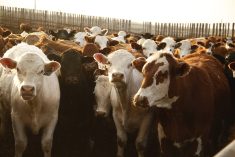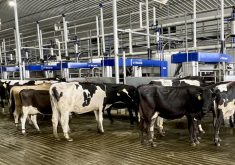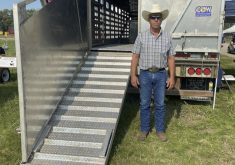Are ancillary therapies often prescribed by veterinarians to enhance bovine respiratory disease (BRD) antibiotic treatment worth the investment?
That’s the question Dr. Jenna Funk, a beef cattle veterinarian at Texas A&M College of Veterinary Medicine & Biomedical Sciences’ (CVMBS) Veterinary Education, Research, & Outreach (VERO), posed during Grey Bruce Farmers’ Week in January.
An ancillary therapy is a non-antibiotic product given with an antibiotic to enhance antibiotic efficacy. These therapies can shorten duration of treatment, reduce instances of retreats, relieve inflammation, block histamine activity and boost the immune system.
Read Also

Jennifer Hayes appointed for second term as the Chairperson of the Canadian Dairy Commission
Jennifer Hayes has been re-appointed as Chairperson of the Canadian Dairy Commission by Heath MacDonald, Minister of Agriculture and Agri-Food.
Why it matters: Ancillary therapies are often prescribed to help enhance antibiotic effectiveness, but research on how well they work is lacking.
“The main struggle we have with ancillary therapies is … whether or not we have controlled studies that look at their effectiveness and what they actually do,” said Funk. “Without research, we don’t know what their true effects are.”
The challenge is weighing the cost of treatment against the financial improvement outcome, whether that’s a reduction in retreatments, chronic pneumonia, dead animals, or to improve the ADG/FE.
Funk said a 2011 Terrell feedlot consultant survey revealed that 47.83 per cent of veterinarians recommended some type of ancillary therapy, with Vitamin C, Banamine, antihistamines and probiotics being the most popular. On a lower scale, viral vaccinations, B-vitamins and Dexamethasone were also prescribed.
Only Vitamin C, Banamine, viral vaccination, Dexamethasone, Meloxicam and Ketoprofen have published controlled research, she said.
Injectable Vitamin C can improve neutrophil function and reduce the case fatality rate, but it requires at least double the label dose to gain effect.
A 1985 research study showed when vitamin C was given to steers treated with Dexamethasone to suppress the immune system, the immune cells, while not increased, were able to function better. A secondary Australian trial in 2008 found animals treated with Vitamin C had a case fatality rate (CFR) of 11 per cent compared to 23 per cent in those without.
“This is a statistically significant difference,” she said. “So, we feel pretty confident that Vitamin C is probably helping reduce the case fatality rates.”
According to the label, Vitamin C is dose-dependent at approximately 2500 mg/animal; however, in 2015, an Oklahoma State research trial of ancillary therapy versus none showed Vitamin C at label doses had no effect.
So what dose should be used? According to Roth’s 1985 study, “the more you use, the bigger effect you got.”
Meloxicam treats pain and reduces inflammation in calves with diarrhea or disbudding of horn buds in calves less than three months old. Additionally, it’s administered to treat inflammation and pain associated with acute clinical mastitis, and abdominal surgery such as caesarean section, said Funk.
“Meloxicam has the potential to reduce lung lesions and create a heavier finished animal,” she said. “Ketoprofen has limited research that it may help reduce lung lesions, but we aren’t sure about that. But we do know it doesn’t improve treatment response when you add it in Draxxin KP.”
A 2005 study of calves treated with injectable Meloxicam and oxytet versus oxytet alone showed a lung lesion rate of 0.5 per cent for the meloxicam group compared to the controls at 2.28 per cent. They also outperformed in final body weight and carcass weight at 22 and 12 kilograms heavier, respectively.
If we reduce lung lesions, we improve the animal’s performance and increase the financial gain, she said.
“That is a legitimate economic benefit with using Meloxicam,” said Funk, adding if live cattle were going for $1.32/lb, that 22 kg of live weight would result in a $63.89 benefit.
In the U.S., it would cost 15 cents per 100 lbs. to treat with a 15 mg Meloxicam tablet which equates to a 1,600-lb. steer treated for $2.40 compared to an injectable or oral drench which runs two dollars a millilitre.
Fever in calves is nature’s response to infection by creating an inhospitable environment for bacteria and viruses; by removing fever, you handicap the normal immune response.
She said that while sick calves do not die due to fever, they do die because of overwhelming respiratory infection.
Average textbook temperatures for a calf range from 101 to 102.9, said Funk, adding that’s not entirely accurate because environmental temperature, meal timing, and feed content along with exercise can impact it.
She said if you chased a calf seven times around the pen before getting it into the chute, the elevated temperature may or may not be related to an infection. Alternatively, it is perfectly normal for a black-hided calf standing in the sun, on a sweltering day, with a rumen full of high energy feed to have a rectal temperature of 106, she explained.
“We do not see organ damage or negative impacts of fever until their internal temperatures reach about 108; anything less I’m okay with,” she said.
The four studies available of Banamine, a non-steroidal anti-inflammatory often used to control BRD-associated fever, showed no economic improvement to justify the added cost because you get the same result with antibiotics alone, said Funk.
While effective at knocking down a fever quickly, Banamine is caustic and creates irritation at the injection site when applied subcutaneously or intramuscularly. In addition, Funk said it produces more pain than relieving it unless injected into the vein. It also increased the meat withhold from four days to 30 when injected into the muscle.
She said that the steroids Dexamethasone and Pred-F are immunosuppressive and can worsen treatment outcomes and suppress immune systems when they are needed to function their best.
Funk said there’s only one published viral vaccine trial and it showed no improved outcomes.
“We have six ancillary therapy treatments that have some research on them, some of it’s not great, but everything else has got nothing,” she said.
“Without peer-reviewed or controlled research trials, it’s very hard to determine whether or not those other ancillary therapies are worth their while.”













